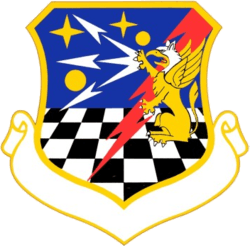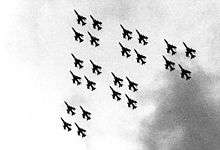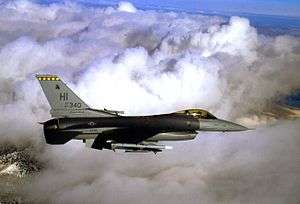419th Fighter Wing
| 419th Fighter Wing | |
|---|---|
|
419th Fighter Wing - General Dynamics F-16C Block 30J Fighting Falcon 87-340 | |
| Active | 27 June 1949-Present |
| Country |
|
| Branch |
|
| Type | Wing |
| Role | Fighter |
| Size | approximately 1,400 personnel |
| Part of |
|
| Garrison/HQ | Hill Air Force Base, Utah |
| Tail Code | Black Tail Stripe/Yellow Diamonds "HI" |
| Commanders | |
| Current commander | Colonel David Smith[1] |
| Current vice-commander | Colonel Al Hawley |
| Current command chief | Chief Master Sergeant Elizabeth P. Atisme |
| Insignia | |
| 419th Fighter Wing emblem |
 |
| Aircraft flown | |
| Fighter | F-16C Fighting Falcon |
The 419th Fighter Wing (419 FW) is an Air Reserve Component (ARC) of the United States Air Force. It is assigned to the Tenth Air Force, Air Force Reserve Command, stationed at Hill Air Force Base, Utah.
The 419th FW is an associate unit of the 388th Fighter Wing, Air Combat Command (ACC) and if mobilized the wing is gained by ACC.
Overview
The mission of the wing is to Fly, Fight and Win. To accomplish that mission, the wing trains and equips an F-16 squadron to be capable of worldwide mobility to perform a wide variety of air-to-air and air-to-ground fighter missions. 419th members are trained in a variety of specialties to include operations, maintenance, civil engineering, security, supply, transportation and communications.
The wing was the last wing to fly F-105 aircraft, and in early 1984 was the first Air Force Reserve wing to fly F-16s. Personnel of the 419th deploy periodically for contingencies and training exercises, some overseas. Some 350 members were deployed December 1994 through February 1995 to Incirlik Air Base, Turkey to patrol the no-fly zone over northern Iraq during Operation Provide Comfort II.
Units
The 419th Fighter Wing is divided into three subordinate groups which supervise nine squadrons and four flights. Additionally, the wing oversees a medical squadron that reports directly to the commander. Several staff agencies such as plans, safety, quality, financial management, public affairs and the legal office form the wing commander’s headquarters section staff.
- The 419th Operations Group plans and organizes operational programs and establishes policies and procedures for operational training functions. It directs, monitors and supports operations programs, including flight operations, standardization/evaluation, weapons and tactics, intelligence, operations and training and life support. The wing’s designated flying squadron is the 466th Fighter Squadron. Pilots from the unit train for both air-to-air and air-to-ground attack missions in the F-16 C/D model aircraft.
- The 419th Maintenance Group plans, organizes and establishes programs, policies and procedures in support of the unit’s flying missions and contingency operations. Subordinate units include the 419th Maintenance Squadron, the 419th Aircraft Maintenance Squadron, and 419th Maintenance Operations Flight. These units train personnel, provide required resources at home and deployed locations, and maintain the wing’s aircraft. The 419th Combat Logistics Support Squadron also falls under the Maintenance Group. Its wartime mission is to deploy teams worldwide to accomplish rapid Aircraft Battle Damage Repair and packing operations.
- The 419th Mission Support Group provides non-tactical support for the operational mission of the 419th Fighter Wing. It provides programs and support to the Security Forces, Communications, Civil Engineer and Mission Support Squadrons. The 419th Security Forces Squadron provides resource protection, system security and base defense missions. The 419th Civil Engineer Squadron provides pre-attack and post-attack civil engineering support necessary to maintain aircraft operations. The 419th Mission Support Flight provides administrative support for the operational mission of the wing. The 419th Logistics Readiness Squadron is responsible for managing personnel and materiel resources. The 67th Aerial Port Squadron also falls under the Mission Support Group. Its members load and unload air freight arriving from and departing for points worldwide.
History
The 419th Group trained in the Reserve for troop carrier operations from 1949 to 1951.
The Air Force Reserve has maintained a flying mission at Hill Air Force Base for more than 45 years. When activated in March 1947, the 419th Group was earmarked to control seven Reserve units, the first of which was a rescue squadron.
During a two-year period, the 419th Group gained several components, spanning five separate locations and three Air Force organizations. Group pilots trained until March 1951 when training ceased and the entire 419th prepared for entry into active service. Activated in July 1956 as a component of the Regular Air Force, the group and its three squadrons trained in C-123 Provider assault airlift operations.
Over the next several years, the wing logged missions in the T-33 Shooting Star, F-80 Shooting Star, F-84 Thunderjet, C-119 Flying Boxcar, C-124 Globemaster II and C-46 Commando aircraft.

In 1972, the Air Force Reserve modernization program added fighter aircraft which resulted in the unit gaining F-105 Thunderchief aircraft. Consequently, the unit was re-designated the 508th Fighter Group.
On 1 October 1982, the unit was upgraded from a group to a wing, being redesignated the 419th Tactical Fighter Wing. It was the last operational F-105 unit in the Air Force until its conversion to F-16s in January 1984.
More than one hundred 419th members were called to active duty in support of Operations Desert Shield and Desert Storm (1991–1992). They served in Saudi Arabia, Europe and at stateside military installations.
Approximately 350 members of the 419th Fighter Wing deployed to Incirlik Air Base, Turkey, in support of Operation Provide Comfort II from 3 December 1994 through 16 February 1995. The wing’s pilots flew more than 500 sorties, compiling more than 1,400 flight hours enforcing the no-fly zone over northern Iraq.
The wing demonstrated its combat capability in a return trip to Incirlik Air Base in June 1997 to support Operation Northern Watch. The unit’s show of force was significant as it deployed 12 aircraft and nearly 400 people to the region to deter the Iraqi military from terrorizing its neighbors. In 1998, the 466th Fighter Squadron deployed 6 aircraft and 93 Reservists to Kuwait in support of Operation Southern Watch.
In June 1999, the 419th Fighter Wing’s deployment to Incirlik Air Base, Turkey marked the first time the Reserve supported a contingency operation by employing precision-guided munitions. After being fired upon by the Iraqi military, pilots utilized Low Altitude Targeting Infrared for Night (LANTIRN) technology to destroy enemy targets with pinpoint accuracy.
419th FW members deployed to Incirlik Air Base in June 2000 where they became the first Reserve unit ever to use a new precision strike capability known as LITENING II in a contingency operation. Their F-16s equipped with the LITENING II technology, 419th pilots helped keep the Iraqi military in check flying 95 combat missions over a 28-day period.
In October 2001, the 419th returned to the Middle East as part of Air Expeditionary Force-8. Wing members used the LITENING II precision strike capability to enforce the no-fly zone over southern Iraq for 19 days.
While deployed, 419th pilots assisted in the United States’ war on terrorism by logging combat missions over Afghanistan during Operation Enduring Freedom. That same month, 419th Security Forces members and Civil Engineers were mobilized and spent 18 months providing security at Air Force installations stateside and overseas.
Members of the wing’s 466th Fighter Squadron supported the North American Aerospace Defense Command by flying combat air patrols at undisclosed locations from 21 December 2001 to 1 January 2002. The wing filled each 8-hour CAP responsibility by utilizing volunteer Reservists and Air Reserve Technicians.
In January 2003, over 100 members of the 419th departed Utah to enforce the no-fly zone over southern Iraq. Once deployed, members were called to active-duty to participate in Operation Iraqi Freedom. During the war, pilots delivered precision-guided weapons on Iraqi command and control facilities, munitions bunkers, radar sites and other key military targets. Several members earned Bronze Star awards and Distinguished Flying Crosses (with heroism) for their actions.
Reservists from the 419th Medical Squadron, 419th Security Forces Squadron and 67th Aerial Port Squadron all supported contingency operations in Iraq in 2004.
Lineage
- Established as 419th Troop Carrier Wing, Medium on 10 May 1949
- Activated in the Reserve on 27 Jun 1949
- Ordered to active duty on 1 May 1951
- Inactivated on 2 May 1951
- Re-designated 419th Tactical Fighter Wing on 22 Feb 1982
- Activated in the Reserve on 1 Oct 1982
- Re-designated 419th Fighter Wing on 1 Feb 1992.
Assignments
- Tenth Air Force, 27 Jun 1949-2 May 1951; 1 Oct 1982-Present
Components
Groups
- 419th Troop Carrier (later, 419th Operations) Group: 27 Jun 1949-2 May 1951; 1 Aug 1992-Present
- 507th Tactical Fighter Group, 1 Oct 1982-1 Apr 1994
- 944th Tactical Fighter Group, 1 Jul 1987-1 Oct 1994
Squadrons
- 466th Tactical Fighter (later Fighter) Squadron, 1 Oct 1982-1 Aug 1992
Stations
- Scott Air Force Base, Illinois, (27 June 1949 – 2 May 1951)
- Hill Air Force Base, Utah, (1 October 1982–Present)
Aircraft operated
- F-16 Fighting Falcon, (1984–Present)
- F-4 Phantom II, (1982–1988)
- F-105 Thunderchief, (1982–1984)
- C/TC-46 Commando, (1949–1951)
- AT-6 Texan, AT-7 Navigator, and AT-11 Kansan, (1947–1951)
Commanders
- Colonel David Smith, November 2015 (current)[1]
- Colonel Bryan Radliff
- Brigadier General Floyd C. Williams February 1999- August 2002
- Brigadier General David E. Tanzi, 11 July 1993– February 1999
- Brigadier General Forrest S. Winebarger, 6 July 1987
- Brigadier General John J. Closner III, 24 July 1983
- Colonel Jonathan Gardner, 1 October 1982
- Colonel Enoch O. Paulson, by Jan 1951–c.2 May 1951
- Colonel Billy G. Dilworth Jr, 12 January 1950
- Brigadier General James H. Howard, 27 June 1949
References
![]() This article incorporates public domain material from the Air Force Historical Research Agency website http://www.afhra.af.mil/.
This article incorporates public domain material from the Air Force Historical Research Agency website http://www.afhra.af.mil/.
- 1 2 Shaw, Mitch (26 November 2015). "New HAFB fighter wing commander well-versed". Hilltop Times. Retrieved 25 November 2015.
External links
- 419th Fighter Wing unit website
- Air Force Link: 419th Fighter Wing factsheet
- GlobalSecurity.org: 419th Fighter Wing
- Air Force Historical Research Agency: 419th Fighter Wing


